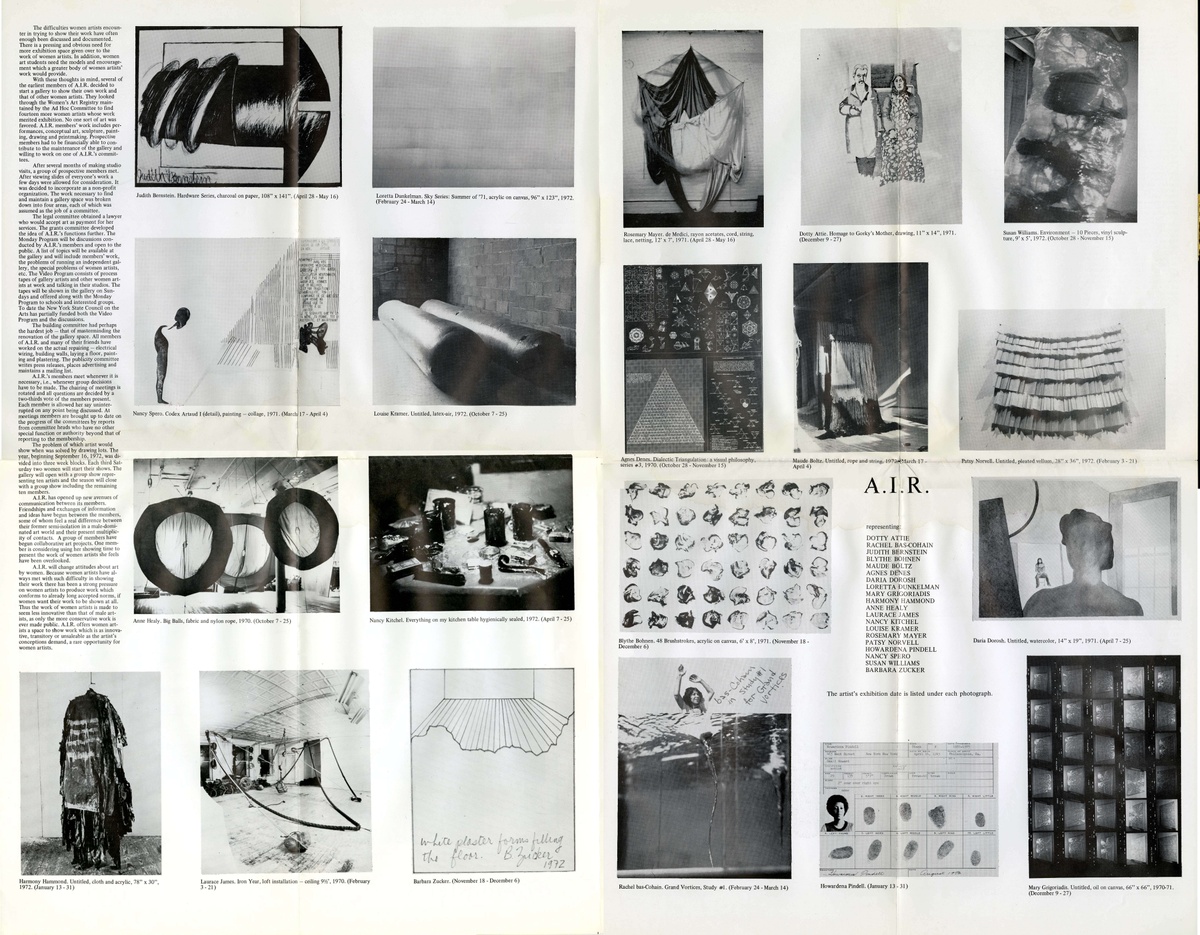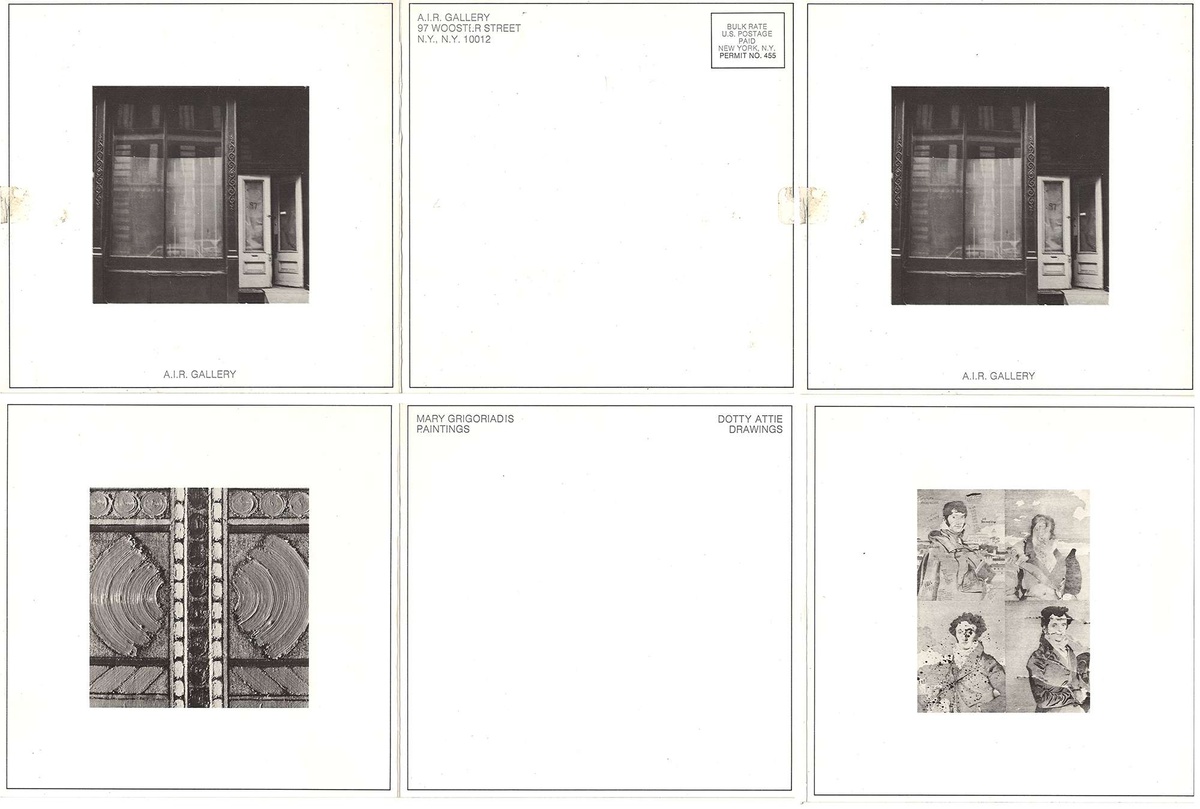A.I.R. Gallery — The First Year
Nicole Kaack Sep 23, 2022 5 Minute Read
This essay is featured in the digital exhibition A.I.R. Gallery: Chapter 1.
A.I.R. Gallery opened its doors on September 16, 1972. The months prior had seen a bustle of activity as the artists had pooled their resources and knowledge to renovate their new space at 97 Wooster Street by hand, apply successfully for a grant from the New York State Council of the Arts, and create the legal structure that, to this day, continues to be the basis of the organization’s by-laws.
While many of the artists came to A.I.R. with different ambitions in mind—using A.I.R. as a project space, a platform for commercial success, a mode of consciousness-raising—they were aligned in their desire to create an artistically rigorous alternative to the institutions and traditional gallery spaces that had denied them for so long. In the flier prepared for A.I.R.’s inaugural event, the artists composed a mission statement that proclaimed the root of their concerns: “A.I.R. will change attitudes about art by women.”

Copyright held by A.I.R. Gallery; digitized as part of a partnership between A.I.R. Gallery and The Feminist Institute, 2022. See record
For all that these twenty artists knew, the first year would be the last. Though they hoped that A.I.R. would continue and that their actions would set new standards for the inclusion of women in the New York art world, their fundraising efforts accounted only for twelve months of experimentation. The exhibition schedule was composed accordingly; the twenty founding artists were split across two ten-person group exhibitions that bracketed an invitational program and a series of two-person shows. The artists quite literally drew lots to decide their place in this sequence. The gallery’s calendar, therefore, did not emerge from curatorial or mission-based considerations; it came rather from the need to represent all founding members within a year of opening. However, the result was a sequence of shows that—by merit of their two-person format—underlined the collaborative spirit at the basis of A.I.R.’s mission to support women artists.
The paper trail of these two-person exhibitions index the artists’ enthusiasm for what they could do together in their new space. As with almost all aspects of the gallery operation, graphic design was an in-house affair, designed by artists on the publicity committee. Rather than giving each artist a separate exhibition invitation, the fliers for the two-person shows were presented as a single, collaborative announcement. The joint exhibition of Dotty Attie and Mary Grigoriadis in December 1972, for example, was publicized in a square, three-part-foldout card. When mailed, the card could be sealed with the gallery address on one side, and a photograph of the storefront on the other. Opening the invitation further would reveal, first, an abstract painting by Mary Grigoriadis and the exhibition dates, then, on a final flap, four drawings by Dotty Attie and both artists’ names. The latticed organization of Attie’s sketches and the crop of Grigoriadis’s laterally reflective painting suggest graphic illustrations of windows—as though the image of A.I.R.’s windowed storefront shone through their work rather than the other way around. The sequential unveiling of the announcement flier likewise hinted at the spatial negotiation that took place in the gallery itself. And while exhibition real estate could be a source of tension, it is thematized in this card instead as a point of pride—a space of their own.

Copyright held by A.I.R. Gallery; digitized as part of a partnership between A.I.R. Gallery and The Feminist Institute, 2022. See record
A.I.R. offered a newfound sense of community for artists who, in their exclusion from a traditional art world, had not had opportunities to open the dialogue around their work. These conversations would be the foundation upon which would grow artistic collaborations. Of course, this wasn’t the first cooperative or artist-run space seen by the art world. However, the women of A.I.R. saw themselves as distinct in creating a women-run model that could support both great artistic ambition and, perhaps more importantly, a communal, democratic apparatus. As founding member Daria Dorosh said in a 2020 oral history interview, “We were really interested in passing on a methodology … Look, this is how it works.”
Nicole Kaack is Editorial Program Manager at the Institute for Studies on Latin American Art (ISLAA), New York, NY, and has formerly held positions at The Museum of Modern Art, New York, NY; The Kitchen, New York, NY; and A.I.R. Gallery, Brooklyn, NY. Her writing has been published by Artforum, BOMB, Art in America, The Brooklyn Rail, Book Art Review, and Sound American. Kaack is co-founder of the collaborative artist book project prompt: and small publisher Not Nothing.